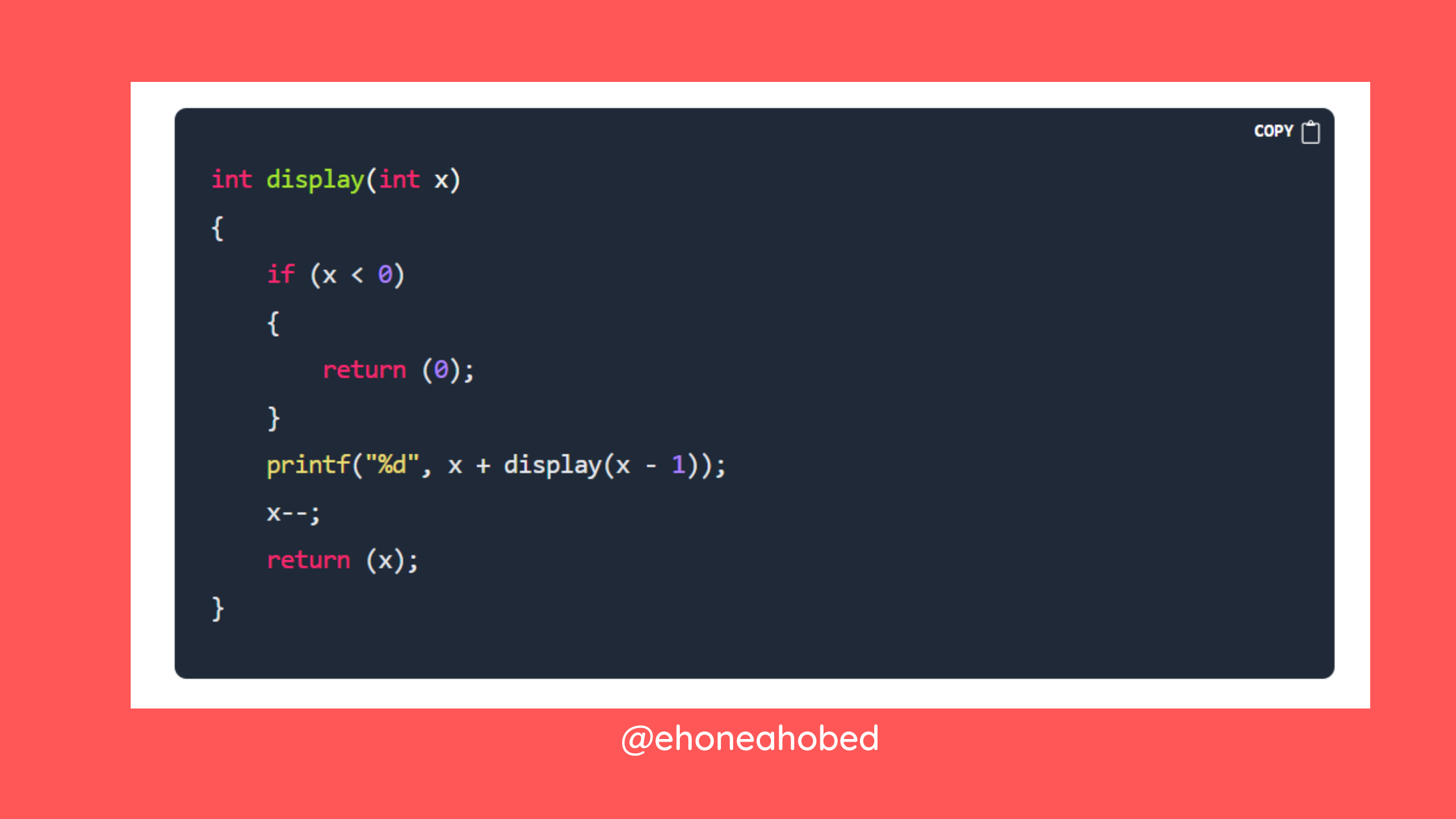What will this Recursive function in C Print and what is the logic behind it?
 Dr. Ehoneah Obed
Dr. Ehoneah Obed
#include <stdio.h>
int display(int x)
{
if (x < 0)
{
return (0);
}
printf("%d", x + display(x - 1));
x--;
return (x);
}
int main(void)
{
display(4);
return (0);
}
To be able to find what the above program will print, you need to understand recursion and how recursive functions work.
The simplest way will be to run the code in a compiler, but being able to deduce it based on the logic of the program is what the question seeks.
I am going to go on and explain the logic behind the code, presuming that you know about recursion and recursive functions. If you have no idea about them, then try and read on them before.
Since the question is looking for the output, we have to be interested in any line of code that prints out something to the screen.
In the code above, you can see that there is only one line that prints out something to the screen and that line is:
printf("%d", x + display(x - 1));
However, the print line even though within the display() function also calls another display() function which makes the function a recursive function.
The presence of the recursion of the function also draws our attention to the return value for the function. This is because, the return value is what will be provided anywhere the function is called.
This means that we need to figure out both what is printed out and what is returned in order to get the right output for the whole code.
Let's therefore take them one by one.
What does this function do and what does it return
int display(int x)
{
if (x < 0)
{
return (0);
}
printf("%d", x + display(x - 1));
x--;
return (x);
}
The first line of the body of the function checks to see if the variable (x) passed to it is less than zero and returns zero if that is true.
The function then goes on to print the sum of the variable plus the return value of the display() function when the argument for the function is x-1.
In the next line, there is a decrement on the variable x before returning the current value of x. The decrement on x means that, we will subtract one from x and return the resulting value.
This means that every time, the display() function is called, it returns one less than the number that was passed to it as an argument. An example will be if we call display(2), then it is going to return 2-1 which be 1.
Since the question gave display(4), it means we need to have the return values for 4, then the printf statement in there will also require the return value for 3 which in turn will require return values for 2, etc.
We will have to keep reducing the numbers till we get to zero. So, let's have a table with the numbers and their return values:
| Display function argument | Return value |
| 4 | 3 |
| 3 | 2 |
| 2 | 1 |
| 1 | 0 |
| 0 | -1 |
| -1 | 0 |
Now that we know what the function does and the values it returns at each stage, we can go ahead look at what the function prints at each stage.
What does the function print at each stage?
printf("%d", x + display(x - 1));
At each stage, the function prints the sum of the argument (x) passed to the function and the return value of the display() function with argument of one less than the initial argument (x-1).
Since we know that, the function in the question above runs multiple times with values starting from 4 down to 0, we have to find the value that will be printed with each value.
Let's use a table to illustrate that.
| Display function argument | What to print value | Argument + Return value | Value printed |
| 4 | 4 + return value for display(3) | 4 + 2 | 6 |
| 3 | 3 + return value for display(2) | 3 + 1 | 4 |
| 2 | 2 + return value for display(1) | 2 + 0 | 2 |
| 1 | 1 + return value for display(0) | 1 + -1 | 0 |
| 0 | 0 + return value for (-1) | 0 + 0 | 0 |
Because of the recursion, the code will print that of display(0) first followed by display(1) then continuously till the last one (display(4) in this case) is printed.
As such, you have the final output being:
00246
Conclusion
I hope I was able to simplify this enough but if you have questions on any of the things I explained above or have some suggestions, you can comment it down below or hit me up on Twitter via a DM and let's chat it out.
Thanks for reading.
Subscribe to my newsletter
Read articles from Dr. Ehoneah Obed directly inside your inbox. Subscribe to the newsletter, and don't miss out.
Written by

Dr. Ehoneah Obed
Dr. Ehoneah Obed
Heya! 👋 I love helping people, and one of the best ways I do this is by sharing my knowledge and experiences. My journey reflects the power of growth and transformation, and I’m here to document and share it with you. I started as a pharmacist, practicing at a tertiary hospital in the Northern Region of Ghana. There, I saw firsthand the challenges in healthcare delivery and became fascinated by how technology could offer solutions. This sparked my interest in digital health, a field I believe holds the key to revolutionizing healthcare. Determined to contribute, I taught myself programming, mastering tools like HTML, CSS, JavaScript, React, PHP, and more. But I craved deeper knowledge and practical experience. That’s when I joined the ALX Software Engineering program, which became a turning point. Spending over 70 hours a week learning, coding, and collaborating, I transitioned fully into tech. Today, I am a Software Engineer and Digital Health Solutions Architect, building and contributing to innovative digital health solutions. I combine my healthcare expertise with technical skills to create impactful tools that solve real-world problems in health delivery. Imposter syndrome has been part of my journey, but I’ve learned to embrace it as a sign of growth. Livestreaming my learning process, receiving feedback, and building in public have been crucial in overcoming self-doubt. Each experience has strengthened my belief in showing up, staying consistent, and growing through challenges. Through this platform, I document my lessons, challenges, and successes to inspire and guide others—whether you’re transitioning careers, exploring digital health, or diving into software development. I believe in accountability and the value of shared growth. Your feedback keeps me grounded and motivated to continue this journey. Let’s connect, learn, and grow together! 🚀